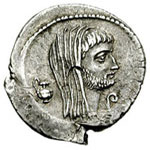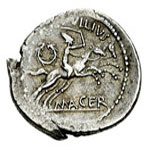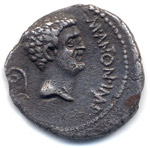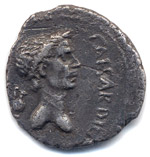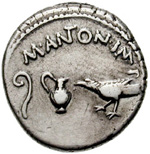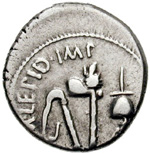Rival Claims: Antony and Caesar
RRC 480/22 © CNG 2004
Obverse: Bearded head of M. Antonius right, wearing veil; before lituus; behind, jug. Border of dots
Reverse: Desultor right, holding reins in left hand and whip in right hand; behind, palm-branch and wreath; above P·SEPVLLIVS; below, MACER. Border of dots
RRC 488/1
Obverse: Head of M. Antonius right, bearded; behind, lituus; before M·A![]() ON·IMP
or M·A
ON·IMP
or M·A![]() O·IMP
downwards. Border of dots.
O·IMP
downwards. Border of dots.
Reverse: Laureate head of Caesar right; behind, jug;
before, CAESAR·DIC downwards. Border of dots.
RRC 489/2 © CNG 2003
Obverse: Lituus, jug and raven; above, M·A![]() ON;
below upside-down, IMP. Border of dots.
ON;
below upside-down, IMP. Border of dots.
Reverse: Simpulum, aspergillum, axe and apex;
around M·LEPID· IMP. Border of dots.
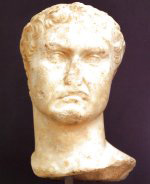
Marc Antony © livius.org
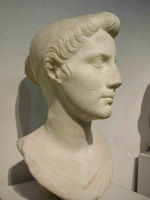
Octavia, Antony's wife and Octavian's sister
The first coin bearing the image of Antony (RRC 480/22) was the final issue produced in the series of the quattuorviri monetales of 44 BC. This is the same series which saw the introduction of the portrait of Caesar on Roman coinage. Antony's type was probably minted in mid-44 BC. On the obverse is a portrait of Antony; he is bearded as a sign of mourning for Caesar, like Octavian (RRC 490/1-4). The obverse also contains the jug and lituus on either side of his portrait to emphasise the legitimacy of his power. The reverse of the coin depicts a Desultor on horseback. Morawiecki (1983: 50) has suggested that the Desultor (someone who leaps between horses at Roman games) was used as a reminder of the greatness of Caesar's ludi Apollonares.
The next issues of Antony were produced from mid-43 BC after he had been declared a public enemy of Rome. They were minted in Gaul and were designed to highlight links with Caesar in an attempt to keep the support of Caesar's veteran armies. RRC 488/1 is a double portrait coin. The obverse depicts Antony and the reverse Caesar. The similarity of their titles and religious symbols suggest that Antony was the political and religious heir of Caesar.
RRC 489/1-2 marks the joining of the armies of Antony and Lepidus at the end of May 43 BC. This issue (with two reverse types) emphasises the equality of the two generals. At the time of minting both Antony and Lepidus were public enemies of Rome and their coin type attempts to demonstrate the legitimacy of their command. The religious symbols used on both the obverse and the reverse represented Antony's augurate and Lepidus' role as heir to Caesar's office of Pontifex Maximus. They also drew on the traditional use of the symbols to stress the legitimacy of the commanders of their armies. The two issues have similar types but different legends. RRC 489/1 describes both the men as COS IMP (Consul Imperator) and RRC 489/2 as IMP (Imperator) alone. But it is clear that they were not elected consuls at this time.
The formation of the Triumviri Rei Publicae Constituendae at the end of November 43 BC saw the issuing of coins commemorating the legal confirmation of their power and the bond of friendship between Antony, Octavian and Lepidus. A gold series (RRC 492/1-2 and 493) featuring individual portraits of the new Triumvirs was struck. RRC 492/1 depicted a portrait of Antony on the obverse and a portrait of Octavian on the reverse, RRC 492/2 depicted a portrait of Antony on the obverse and a portrait of Lepidus on the reverse and RRC 493 depicted a portrait of Octavian on the obverse and a portrait of Antony in the reverse. The issues of the quattuorviri monetales continue the themes of military power and domination, friendship and reconciliation, and abundance and fortune. They combine to represent a positive image of a new age (Buttrey 1956:34-5). One of the aureii (RRC 494/2) issued by L. Livineius Regulus celebrating the divine ancestry of the Triumvirs links Antony with Hercules.

